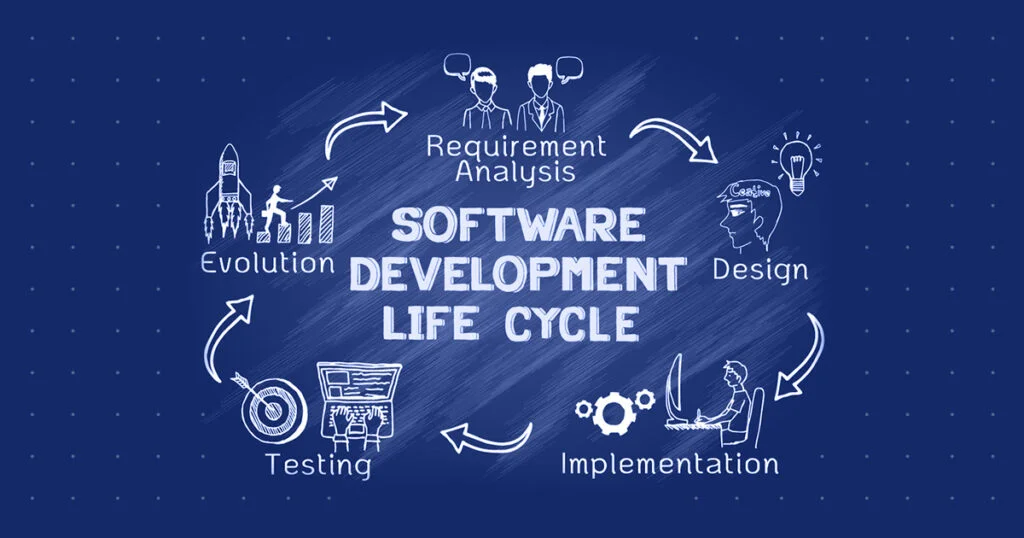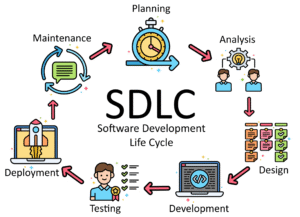What is SDLC?
Definition & Importance
The Software Development Life Cycle (SDLC) is a structured process used by software developers and project managers to plan, design, build, test, and deploy software systems. It helps ensure quality, efficiency, and project control from start to finish.
SDLC enables teams to deliver high-performance software that meets client requirements, budget expectations, and delivery timelines. Whether you’re developing a mobile app, enterprise software, or a web application, SDLC ensures your project stays on track.
SDLC Phases Explained
Here are the 7 key phases of the software development life cycle, each with its own purpose and deliverables:
1. Requirement Gathering & Analysis
This is the first and most critical phase. Project managers and business analysts work with stakeholders to collect and analyze business needs.
Deliverable: Software Requirement Specification (SRS) document
2. Planning
In this phase, teams define project scope, budget, timelines, resources, and risk management strategies.
Deliverable: Project development plan
3. Design
Architects and developers prepare both high-level and low-level designs of the system including architecture, wireframes, and data flow.
Deliverable: Design Document Specification (DDS)
4. Development (Coding)
Developers write code using predefined technologies and frameworks. This is where the actual software is built.
Deliverable: Functional software or application
5. Testing
Testing engineers validate the product against the requirements. Tests include unit testing, integration testing, system testing, and UAT (User Acceptance Testing).
Deliverable: Test reports and a bug-free product
6. Deployment
After successful testing, the software is deployed to a production environment. It may be released in phases or all at once.
Deliverable: Live, usable software
7. Maintenance & Support
Post-deployment, the software requires regular updates, troubleshooting, and enhancements to keep it relevant and functional.
Deliverable: Maintenance logs, updated software versions
🔁 Popular SDLC Models
✅ Waterfall Model
A linear and sequential approach — each phase starts after the previous one finishes. Best for small or fixed-scope projects.
✅ Agile Model
An iterative and flexible method that emphasizes continuous feedback, collaboration, and incremental delivery.
✅ Spiral Model
Combines iterative development with risk assessment — great for large, high-risk projects.
✅ V-Model
Focuses on verification and validation — each development phase has a corresponding testing phase.
Benefits of Using SDLC
-
Cost Efficiency – Saves resources through better planning and risk management
-
Timely Delivery – Keeps the project aligned with deadlines
-
High Quality – Structured testing ensures a stable product
-
Clear Documentation – Improves traceability and accountability
-
Scalability & Maintenance – Easy to upgrade and maintain over time
Common Mistakes in SDLC (And How to Avoid Them)
-
Incomplete requirement analysis
-
Skipping quality assurance and testing
-
Inadequate communication between teams
-
Ignoring post-launch maintenance
-
Choosing the wrong SDLC model
SDLC Best Practices for Developers & Teams
-
Use version control tools (like Git/GitHub)
-
Incorporate CI/CD pipelines for automation
-
Adopt Agile for dynamic environments
-
Include end-users in the feedback loop
-
Maintain updated documentation
-
Conduct regular code reviews and audits
Conclusion
The Software Development Life Cycle is not just a technical guideline—it’s the foundation of successful software engineering. By choosing the right SDLC model and following best practices, teams can build scalable, secure, and user-friendly software that delivers real value.
Whether you’re an IT startup, software house, or enterprise business, understanding and implementing SDLC is key to digital transformation and long-term success.




